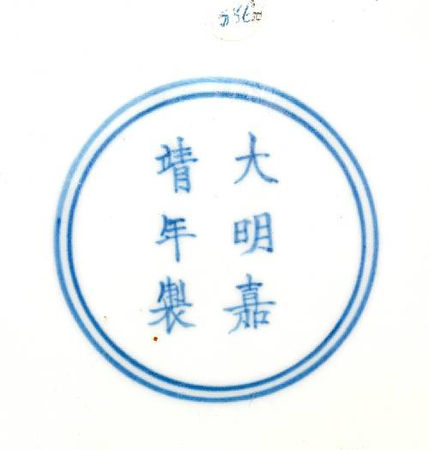Imperial Ming Jar Takes the £1.1m Biscuit at Bonhams Chinese Art Sale
A rare enamelled and blue and white 'fish' jar, guan. Jiajing six-character mark and of the period
A splendid Ming dynasty jar, a rare survivor from a vanished era of Imperial Chinese prestige, sold on 4.5.09 for £1,117,600 in a packed sale at Bonhams New Bond Street.
Created in the reign of the Emperor Jiajing (AD1522-66), and estimated to sell for up to £250,000, the elegant understated blue and white jar with highlighted goldfish, came from the collection of the Palmer family, of Huntley and Palmer fame. This sale was without doubt a highlight of London’s Summer Asia Week Chinese art auction sales.
The Chinese Art Sale, taken by Colin Sheaf, Bonhams Deputy Chairman and Head of Asian Art, saw prices dispel any notion of economic gloom. The items from the Palmer Collection performed exceptionally strongly with many achieving ten and twelve times their pre-sale estimates.
After the sale Colin Sheaf said: “Items like this with impeccable provenance, great rarity and the highest quality always seem to retain their value and in fact grow it over the years. There is only a very limited number of objects of this rarity and beauty available.”
The Palmer golden carp jar has remained with the family ever since its first (and last) appearance at a London auction in 1935. One of only very few remaining in public and private collections, this auspicious jar generated such great interest because of its lustre, its Imperial Chinese ownership, outstanding potting craftsmanship, freshness to the auction arena, and provenance from an historically significant English collection.
Golden carp fish were highly prized by Chinese connoisseurs during the Ming Dynasty, both for their rarity, and for their association with the images of great wealth and success. One 16th Century Ming Emperor of China appreciated this subtle blending of imagery so much that he commissioned porcelain to be decorated at the Imperial kilns with this rare design, which he then ordered to be displayed in the palaces at his capital, Beijing.
Painted in vibrant blue and gold, the jar will appeal to any of the worlds great collectors of Chinese porcelain, mostly based in Chinese-speaking Asia. Many of them know that designs on Imperial Chinese porcelain often carry subtle allusions, and represent literary messages to be understood by the cognoscenti. Here the association is explicit: expensive porcelain, potted and painted to the exacting standards of an Emperor, carries unambiguous images of wealth and prestige. Even today, golden carp are carefully bred to maximise the distinctive markings beloved of Chinese collectors. The colour gold reverberates down the centuries, as an unmistakable statement that the Ming owner of this jar was a man of the greatest financial substance.
Nothing is known of the early travels of this golden carp jar, until it came to auction in England about four hundred years later. It was always too expensive, too Imperial to be exported as part of the English East India Companys annual shipments of Chinese goods, which enriched British interiors over two centuries: Chinese export furniture, lacquer, fans, wallpaper, and of course porcelain dinner and tea services, flower pots, sets of mantelpiece vases. This jar was far grander in conception and execution than any Chinese Export service painted with a Western familys coat-of-arms.
Its recorded history in Europe begins in 1935, when it appeared at a London auction from the famous collection of Charles Russell. Sold to the best-known London dealer in Chinese art, Bluett and Sons, it entered an equally famous English private collection in the same year for the princely sum of £55.
This collection of Chinese porcelain and other art was being formed by a leading British businessman, Reginald Palmer, chairman of the internationally successful biscuits and cakes company Huntley and Palmer. The factory was based at Newbury, Berkshire; and his large country house, nearby, came to be liberally furnished with top-quality Chinese art, especially porcelain and jade. This was increasingly available to buy from London dealers, because the breakdown of Chinese Imperial authority and the abolition of dynastic government in 1911 had led to large quantities of Imperial Palace art being sold to the art dealers of Beijing and Shanghai, and subsequently shipped to London.

/https%3A%2F%2Fprofilepics.canalblog.com%2Fprofilepics%2F1%2F0%2F100183.jpg)







/http%3A%2F%2Fstorage.canalblog.com%2F93%2F29%2F577050%2F66520041_o.jpg)
/http%3A%2F%2Fstorage.canalblog.com%2F38%2F84%2F119589%2F66518392_p.jpg)
/http%3A%2F%2Fstorage.canalblog.com%2F89%2F15%2F119589%2F66422513_p.jpg)
/http%3A%2F%2Fstorage.canalblog.com%2F64%2F75%2F577050%2F65928955_o.jpg)